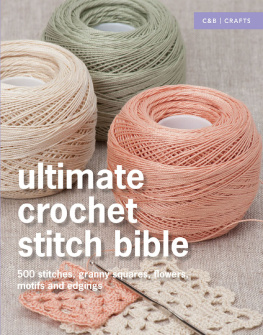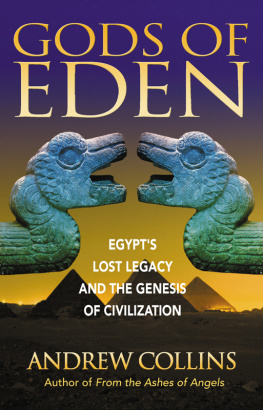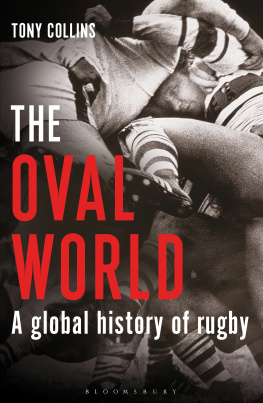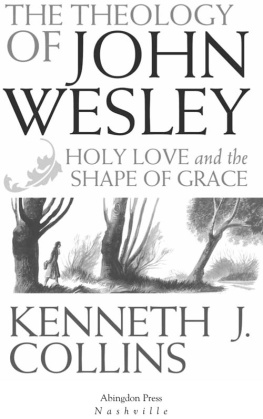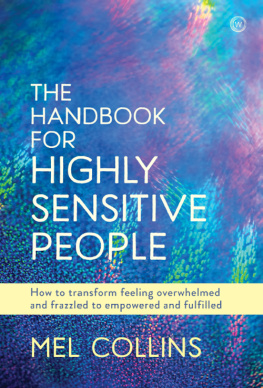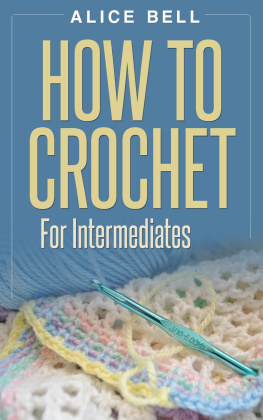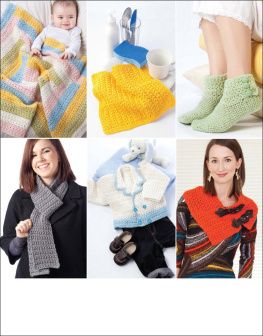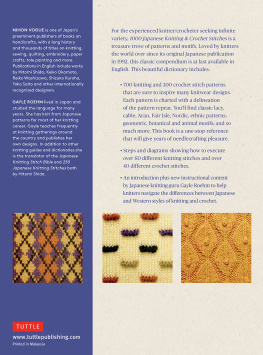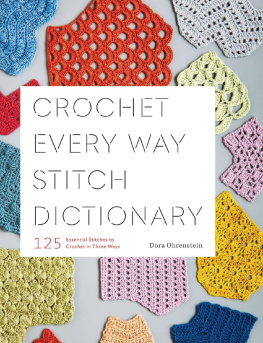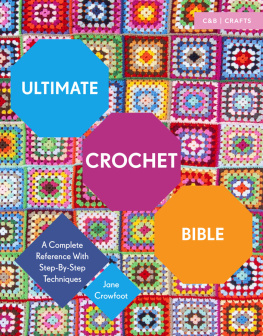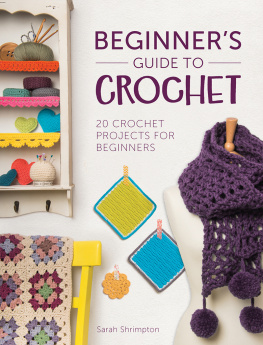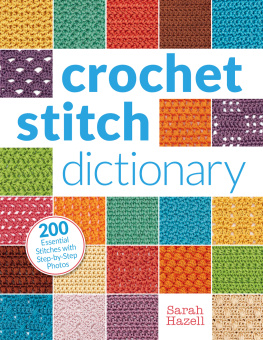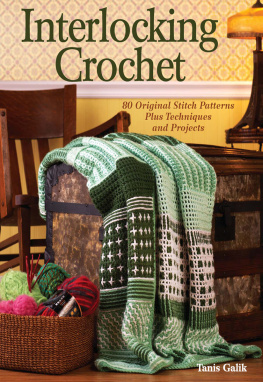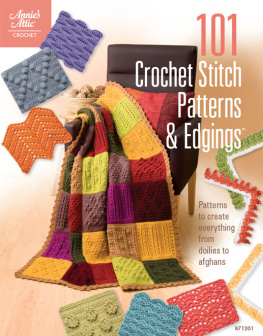Collins - Ultimate Crochet Stitch Bible
Here you can read online Collins - Ultimate Crochet Stitch Bible full text of the book (entire story) in english for free. Download pdf and epub, get meaning, cover and reviews about this ebook. year: 2015, publisher: Pavilion Books, genre: Home and family. Description of the work, (preface) as well as reviews are available. Best literature library LitArk.com created for fans of good reading and offers a wide selection of genres:
Romance novel
Science fiction
Adventure
Detective
Science
History
Home and family
Prose
Art
Politics
Computer
Non-fiction
Religion
Business
Children
Humor
Choose a favorite category and find really read worthwhile books. Enjoy immersion in the world of imagination, feel the emotions of the characters or learn something new for yourself, make an fascinating discovery.
- Book:Ultimate Crochet Stitch Bible
- Author:
- Publisher:Pavilion Books
- Genre:
- Year:2015
- Rating:5 / 5
- Favourites:Add to favourites
- Your mark:
- 100
- 1
- 2
- 3
- 4
- 5
Ultimate Crochet Stitch Bible: summary, description and annotation
We offer to read an annotation, description, summary or preface (depends on what the author of the book "Ultimate Crochet Stitch Bible" wrote himself). If you haven't found the necessary information about the book — write in the comments, we will try to find it.
Collins: author's other books
Who wrote Ultimate Crochet Stitch Bible? Find out the surname, the name of the author of the book and a list of all author's works by series.
Ultimate Crochet Stitch Bible — read online for free the complete book (whole text) full work
Below is the text of the book, divided by pages. System saving the place of the last page read, allows you to conveniently read the book "Ultimate Crochet Stitch Bible" online for free, without having to search again every time where you left off. Put a bookmark, and you can go to the page where you finished reading at any time.
Font size:
Interval:
Bookmark:
ultimate crochet stitch bible
500 stitches, granny squares, flowers, motifs and edgings



Crochet is perhaps the most versatile of all crafts. Using just a hook and a ball of yarn, it is possible to create a fabric from almost any length of continuous fibre: wool, cotton, string, ribbon, leather, wire, and even plastic bags cut into strips!
Quite simply, crochet is a series of interlocking loops of thread worked into a chain using a thin rod with a hook at the end. A chain of loops is formed, with each new loop catching the thread and pulling it through the previous loop. After the chain is completed, the thread is then turned to start a second chain, and so on, until a fabric is created and one that grows rather more quickly than knitting.
Crochet can often prove to be easier than knitting, as working with just one stitch on a crochet hook at a time is simpler than handling a number of stitches on a knitting needle. There are just a handful of basic stitches (); each one is easily mastered, and the variations and combinations of these are endless.
Crochet is one of the most basic forms of textile, having an affinity with fishermens nets and medieval lace: the very word crochet is French for hook. The craft also has an affinity with knitting; early knitting frames used a single, hooked needle, and it may well be that the looping effect gave birth to the crochet technique.
In the past, crochet designs were not usually written down, just lovingly remembered, and handed down from generation to generation. Crochet as we recognize it today became popular in the late 1930s and 1940s as a cheaper alternative to lace. Crochet soon adorned utilitarian collars and cuffs, and even snoods, giving femininity and a little glamour to the clothes of the austere war years. A revival in the 1960s took crochet to new heights, with colourful, freeform hangings, even hanging chairs, and of course the quintessential crochet minidress.
This edition is just a starting point for your own interpretation. It offers a selection of the very best stitches, including a few new ones and some reinvented for a new generation.
The book is divided into three main sections. The first covers . The emphasis here is on texture, and we show how combinations of the basic stitches can be used to make a huge variety of different crochet fabrics, featuring shells, chevrons, puff stitches, trellis stitches and loop stitches, among others.
The second section focuses on motifs () in a variety of shapes: circular, square, polygonal, triangular as well as leaf and petal shapes. Regular-shaped motifs can be made in multiples and stitched together to create items such as throws and blankets. Many of the circular or flower-like motifs would work well as embellishments, for example, on hats, or as brooches.
The third section covers edgings and trims (), ranging from simple cords and braids to more elaborate ruffles and frills. Crochet trims can be used to decorate a plain knit or crochet item, adding a special something to a hem, cuff, neckline or plain blanket edge.
Although there is a wealth of ideas in this book, you can think of it as just a starting point for your own creativity. Building on this knowledge, you might find inspiration for your own crochet stitches and designs in many everyday things: the worn walls of buildings, patterned pavements, undulating tiles, the delicate stamens of flowers, even tangled and broken wire-mesh fences; seemingly mundane items, but inspiring in their form and design.

It is sometimes hard to believe that beautiful and intricate-looking crochet is created using only two essential tools: a crochet hook and the yarn itself.
Crochet hooks are usually made from steel, aluminium or plastic in a range of sizes according to their diameter. As each crochet stitch is worked separately until only one loop remains on the hook, space is not needed to hold stitches.

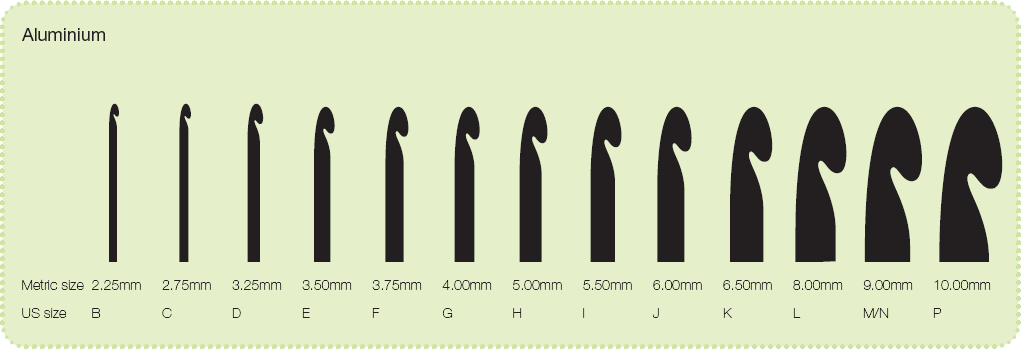
Traditionally, crochet was worked almost exclusively in very fine cotton yarn to create or embellish household items such as tablecloths, doilies, cuffs and frills. The samples in this book were worked in a fine mercerized cotton, but may take on a totally different appearance if different yarns are used. Lacier stitches probably look their best in smooth threads, but some of the all-over stitches can be more interesting when worked in tweedy or textured yarns. Crochet yarns can also be found in leather, suede and even fine jewellery wire.
There are no hard and fast rules as to the best way to hold the hook and yarn. The diagrams below show one method, but you can choose whichever way you find the most comfortable.
Due to the restrictions of space it is not possible to show diagrams for both right- and left-handed people. Left-handers may find it easier to trace the diagrams and then turn the tracing paper over, thus reversing the image; alternatively, reflect the diagrams in a mirror. Read left for right and right for left where applicable.

The hook is held in the right hand as if holding a pencil.

To maintain the slight tension in the yarn necessary for easy, even working, it can help to arrange the yarn around the fingers of the left hand in this way.
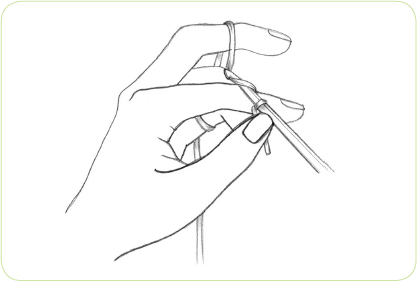
The left hand holds the work and at the same time controls the yarn supply. The left-hand middle finger is used to manipulate the yarn, while the index finger and thumb hold on to the work.
The patterns in this book use the following basic stitches. They are shown worked into a starting chain, but the method is the same whatever part of the work the stitch is worked into.
To be able to start a crocheted piece the first step is to secure the working yarn on to the hook. You will need to make a slip knot to create the first loop on the hook, while a yarn over is the way you will make all subsequent loops.

Font size:
Interval:
Bookmark:
Similar books «Ultimate Crochet Stitch Bible»
Look at similar books to Ultimate Crochet Stitch Bible. We have selected literature similar in name and meaning in the hope of providing readers with more options to find new, interesting, not yet read works.
Discussion, reviews of the book Ultimate Crochet Stitch Bible and just readers' own opinions. Leave your comments, write what you think about the work, its meaning or the main characters. Specify what exactly you liked and what you didn't like, and why you think so.

